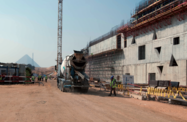The year 2015 brought welcome stabilisation and recovery to Egypt, after a difficult post-revolution period marked by continued upheaval and sluggish growth.
The first part of the year saw a range of encouraging developments, including the completion of the strategically vital Suez Canal expansion, the commitment of more than $35bn in planned foreign investments, closer economic ties with Gulf allies and promising activity in the fast-moving consumer goods (FMCG) sector.
The Egyptian economy is expected to continue growing at a steady pace in the coming months, with key sectors, such as manufacturing and ICT, looking particularly promising.
However, headwinds from a jittery global economy present significant downside risks, and structural domestic challenges – including a fiscal deficit and stubborn poverty and unemployment rates – remain.
Growth prospects
Egypt’s GDP grew by 4.2% in 2015, according to the IMF, up from 2.2% in 2014 and marking the first year of a return to pre-2011 growth levels. Looking ahead, the fund expects GDP to expand by 4.3% in 2016 before scaling up to 5% by 2019. The World Bank has issued slightly lower projections, forecasting 3.8% growth in FY 2015/16, down from its previous estimate of 4.5%.
One of the major highlights of the year was the Egypt Economic Development Conference (EEDC), held in March. At the event, Egypt secured investment contracts worth around $36.2bn, along with an additional $18.6bn in infrastructure contracts to construct power plants.
The pledges at the EEDC were a combination of aid and investment, according to media reports, with much of it from Gulf Cooperation Council (GCC) member states.
The UAE pledged $2bn in investment and $2bn in deposits to the Central Bank of Egypt (CBE), while Saudi Arabia promised $3bn of investments and $1bn in central bank deposits. Kuwait, meanwhile, pledged $4bn in investment, and Oman offered $500m, to be split evenly between aid and investment, over the next five years.
The offers of support from the Gulf followed on another $12bn worth of funding from Saudi Arabia, Kuwait and the UAE – a mixture of grants, deposits at the CBE and petroleum products – pledged in 2013 after the ousting of then-president Mohammed Morsi.
Rough patch
Loans offered by international financial institutions at the EEDC reached $5.2bn, in addition to the GCC pledges of $12.5bn of additional economic assistance. The measures should help stimulate long-term growth but most importantly provide crucial cash to bolster Egypt’s dwindling foreign exchange reserves.
Egypt has drawn on its reserves to prop up the pound in the years since 2011, with the country’s import cover falling to around 3.4 months as of end-December.
While the CBE’s efforts seem to have shielded the Egyptian pound from the double-digit depreciations recorded in many emerging markets in 2015, the currency nonetheless lost nearly 9% of its value against the US dollar over the course of the year, and remains overvalued, according to many analysts.
Inflation rose slightly over the period, reaching 11.1% year-on-year in December 2015, according to CBE figures, up from 10.1% one year prior.
The long game
In spite of the short-term pressures, however, the country has managed to complete an impressive set of infrastructural improvements, which should leave it well positioned for long-term growth.
The most visible evidence of this is the expanded Suez Canal. Inaugurated in early August after taking just 12 months to complete, the $8bn expansion of the 163-km waterway includes 35 km of new channels and a 37-km stretch where the canal was widened to accommodate larger ships.
According to the state-run Suez Canal Authority, the New Suez Canal should allow canal revenues – one of the primary foreign exchange earners for the country – to more than double to $13.2bn by 2023.
An average of 97 ships are expected to pass through the waterway daily, up from 49 before the expansion, although the authority’s estimates could prove on the high side if sluggish growth in global trade persists.
The Baltic Dry Index, which measures the price of shipping bulk cargo around the world and is used as a proxy for global trade growth, fell to a record low in early January, at 468 points.
Nonetheless, the canal is earmarked to play an important role in Egypt’s development, both as a driver of traffic in the approaching decades and a catalyst for the emergence of new economic zones around the canal.
The Suez Canal Zone development project is targeting $68bn-100bn in investment through to 2023, across targeted sectors that include manufacturing, logistics and ICT.
Diversification
The development of the broader area around the zone is part of the government’s efforts to stimulate activity and investment in key secondary and tertiary sectors, and in turn increase rates of job creation.
The government is looking to attract LE12bn-15bn ($1.5bn-1.9bn) in investment in areas surrounding the canal in a bid to build on its position as a global centre for ICT outsourcing and offshoring.
In addition to ongoing developments around the canal, the country’s large FMCG sector is likely to be a growth driver in 2016, building on momentum from a flurry of mergers, acquisitions and investments in 2015.
Sector highlights from the past year include US-based Kellogg’s purchase of an 86% stake in Egypt’s Bisco Misr in January 2015 and its acquisition of Mass Food Group in September, for $125m and $50m, respectively.
Meanwhile, Egyptian food producer Edita Food Industries held a successful initial public offering of 30% of its shares on the Egyptian Stock Exchange in March, with the issue 4.5-times oversubscribed, indicating robust investor appetite.
Oxford Business Group is now on Instagram. Follow us here for news and stunning imagery from the more than 30 markets we cover.

